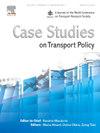Public perceptions and support for policies enhancing safety and justice in connected and automated vehicles and vulnerable road users interactions
IF 3.3
Q3 TRANSPORTATION
引用次数: 0
Abstract
Despite the anticipated benefits, the rollout of Connected and Automated Vehicles (CAVs) is likely to encounter numerous challenges, including public readiness to adopt and coexist with these vehicles. This study utilised a cross-sectional survey of 384 Australian residents aged 18 to 82 (M = 42.93, SD = 15.48) to assess public perceptions and support for policies designed to enhance safety and justice in interactions between CAVs and vulnerable road users (VRUs) such as pedestrians, cyclists and people with disabilities. Participants evaluated 15 policies (identified through a structured, expert-informed process as a preliminary stage) across five evaluation dimensions: acceptability for improving safety within the transport system, acceptability for improving justice within the transport system, perceived improvement of safety for all VRUs, perceived improvement of justice for all VRUs, and willingness to support each policy. Data were analysed using descriptive statistics, cluster analysis, and hierarchical regression models. Policies focusing on systemic improvements, such as VRU-focused infrastructure and technology enhancements, received strong public support. Public preferences align with policies promoting fairness and inclusivity, while punitive measures and VRU-burdening policies were resisted. Cluster analysis identified three groups: VRU-burdening policies (low support), VRU-centric safety policies (moderate support), and VRU-focused infrastructure and technology policies (high support). Regression analyses revealed that factors such as age, transport accessibility, and disability influenced policy support. A content analysis revealed a strong preference for prioritising public transport investment, implementing inclusive urban designs, and establishing robust ethical frameworks. The findings highlight the need for policies that prioritise VRU safety and justice in CAV deployment. Support for inclusive, non-punitive measures points to the importance of fairness and system-wide reforms. To transition toward a safer, more equitable transport system, the study suggests the potential for more radical, community-driven policies and increased transparency in CAV development.
公众对加强互联和自动驾驶车辆以及弱势道路使用者互动安全与公正的政策的看法和支持
尽管有预期的好处,但联网和自动驾驶汽车(cav)的推出可能会遇到许多挑战,包括公众是否准备好采用这些车辆并与之共存。本研究对384名年龄在18岁至82岁之间的澳大利亚居民(M = 42.93, SD = 15.48)进行了横断面调查,以评估公众对旨在加强自动驾驶汽车与弱势道路使用者(如行人、骑自行车的人和残疾人)之间互动的安全和正义的政策的看法和支持。与会者评估了15项政策(通过结构化的专家知情过程作为初步阶段确定),涉及五个评估维度:改善运输系统内安全的可接受性、改善运输系统内司法的可接受性、所有vru安全的可感知改善、所有vru司法的可感知改善以及支持每项政策的意愿。采用描述性统计、聚类分析和层次回归模型对数据进行分析。以系统改进为重点的政策,如以vru为重点的基础设施和技术改进,得到了公众的大力支持。公众偏好与促进公平和包容的政策一致,而惩罚性措施和vru负担政策受到抵制。聚类分析确定了三组:vru负担策略(低支持)、以vru为中心的安全策略(中等支持)和以vru为中心的基础设施和技术策略(高支持)。回归分析显示,年龄、交通可达性和残疾等因素影响政策支持。一项内容分析显示,人们强烈倾向于优先考虑公共交通投资、实施包容性城市设计和建立健全的道德框架。研究结果强调了在CAV部署中需要制定优先考虑VRU安全和公正的政策。对包容性、非惩罚性措施的支持表明了公平和全系统改革的重要性。为了向更安全、更公平的交通系统过渡,该研究建议采取更激进的、社区驱动的政策,并提高自动驾驶汽车开发的透明度。
本文章由计算机程序翻译,如有差异,请以英文原文为准。
求助全文
约1分钟内获得全文
求助全文

 求助内容:
求助内容: 应助结果提醒方式:
应助结果提醒方式:


